Contents
- Dark Rooms & Shade-Hating Plants
- Sun-Filled Rooms (South-Facing Rooms & Conservatories, etc.)
- Bedrooms (Air-Purifying Plants For Better Well-Being & Sleep)
- Bathrooms
- Cold or Draughty Rooms
- Radiator-Tolerate Plants
- Placing Houseplants Outdoors
N. B. - To find a specific plant, either click on the 'Share' button & press 'Find On Page' with phones, or via Control F on computers (Command F on Apple Mac).
Need the answer to a specific plant query? Book a 1-to-1 video call with Joe Bagley, the website's friendly author, to overcome and address your niggling problem! Available on iMessage, WhatsApp, Facebook Messenger & more.
Dark Rooms / North Facing Rooms
This section consists of specimens that can survive in shady locations, where a newspaper can be read without the use of artificial lighting. When situating any plant in a less-favourable condition, it's essential to follow some essential tips to avoid death.
- Reduce the frequency of irrigations - Due to the lower rates of photosynthesis, the plant won't require as much water, especially over the winter months. Keeping the soil slightly more on the dry side will alleviate the risk of root rot. Further, stab the soil in multiple places once a month with a chopstick to promote better airflow around the roots. Leave the holes open for a few days and re-shift the compost shortly before the next irrigation. It'll mimic the actions of small invertebrates like worms that shift the soil structure around the roots, along with adding small air pockets and downplaying the chance of stagnation. This method is best performed on specimens grown in big pots or situated in shady locations.
- Dust the leaves regularly - Like other domestic surfaces, the leaves will slowly be covered with a thin layer of dust. This will not only reduce its light-capturing efficiency, but it'll also weaken the overall health of the plant due to the lack of photosynthetic energy. Wash its foliage in the shower or with a hose at monthly intervals to alleviate this problem.
- Never situate a diseased or weakened plant in a shady spot as the combination of this and lower light levels will result in death. When a specimen is under stress, it's essential to give it the fundamental necessities of proper cultivation - bright, indirect light, a right level of soil moisture and nutritious compost. Only use healthy, disease-free specimens in a darker location to avoid disappointment.
- Dark settings will come at the cost of variegations. As photosynthesis requires chlorophyll (green foliage) to produce storable sugars, its patterns will begin to fade over a few months. If you're not bothered with this change, don't worry; but for those who crave variegated texture, provide a bright, indirect location for maximum patterns.
- Regular fertilisations are essential as many of the thirteen primary nutrients are linked to photosynthesis and respiration. A forgetful gardener who doesn't supplement the soil regularly will promote a nutrient deficiency, which can lead to a weakened specimen and possible death. Always follow the recommended guidelines to fertilisation, and if you're unsure of which products to use, click here!
- Keep an eye out for pests, especially with Mealybugs and Spider Mite. Allowing an infestation to engulf a specimen in a dark location will add further stress to its wellbeing. Again, only use problem-free plants to decorate a shady corner as the risk of decline and death are only a step away.
- Plants will be under more stress when situated in a dark room over the winter months. It's recommended to relocate the plant to a brighter location during this period, however, if it can't, keep the soil on the drier side to reduce the risk of over-watering or root rot.
- Aspidistra - Cast Iron Plant
- Baby Tears - Soleirolia or Helexine
- Bromeliads - Aechmea, Billbergia, Bromelia, Cryptanthus, Guzmania, Helicodea, Vrisea & Others
- Calathea - Prayer or Living Plants
- Chinese Evergreens
- Devil's Ivy - Epipremnum, Scindapsus & Pothos
- Dracaena - Dragon Tree, Corn Plants & Lucky Bamboo
- English or Common Ivy - Hedera
- Fatsia japonica
- Ferns - Boston (Nephrolepis), Blechnum, Dryopteris, Maidenhair (Adiantum), Rabbit Foot Ferns & Others
- Fittonia - Nerve Plants
- Jewel Orchids - Ludisia
- Maranta
- Maidenhair Vines - Meuhlenbeckia
- Monstera - M. deliciosa, M. adansonii, M. obliqua, M. minima (Rhaphidophora tetrasperma) & Others
- Palms - Parlour, Areca, Fishtail*, Lady & Kentia Palms. *Not Pet-Friendly
- Peace Lilies - Spathiphyllum
- Persian Shield - Strobillanthes dyerianus
- Philodendron
- Sansevieria (Mother-in-Law's Tongue / Snake Plant, Rocket Plant, African Spear, etc.)
- Schlumbergera - Christmas, Holiday, Thanksgiving & Easter Cactus
- Senecio cephalophorus
- Spider Plants
- Swedish Ivy - Plectranthus verticullatus
- Tradescantia - Inch Plants
- ZZ Plants
N. B. - Plants in bold are pet-friendly.
Plants That Shouldn't Be Placed in Shady Spots
- Bulbs - Amaryllis, Crocus, Daffodils (Narcissus), Hyacinths & Tulips.
- Herbs - Basil, Chives, Dill, Mint, Lemon Grass, Oregano, Parsley, Rosemary, Thyme, etc.
- Orchids - Moth Orchids (Phalaenopsis), Dendrobiums, Cymbidiums, Epidendrums, Cattleya, Paphiopedilum & Others
- Most Flowering Plants - Azalea, Bougainvillea, Calla Lily (Zantedeschia), Campanula, Chrysanthemum, Cyclamen, Flaming Katie, Gardenia, Geranium, Gerbera, Gloxinia, Streptocarpus, Primula & Siam Tulips.
- Vegetables & Fruits - Capsicum (Peppers), Tomatoes & Strawberries, etc.
- Sago Palms - Cycads & Zamia
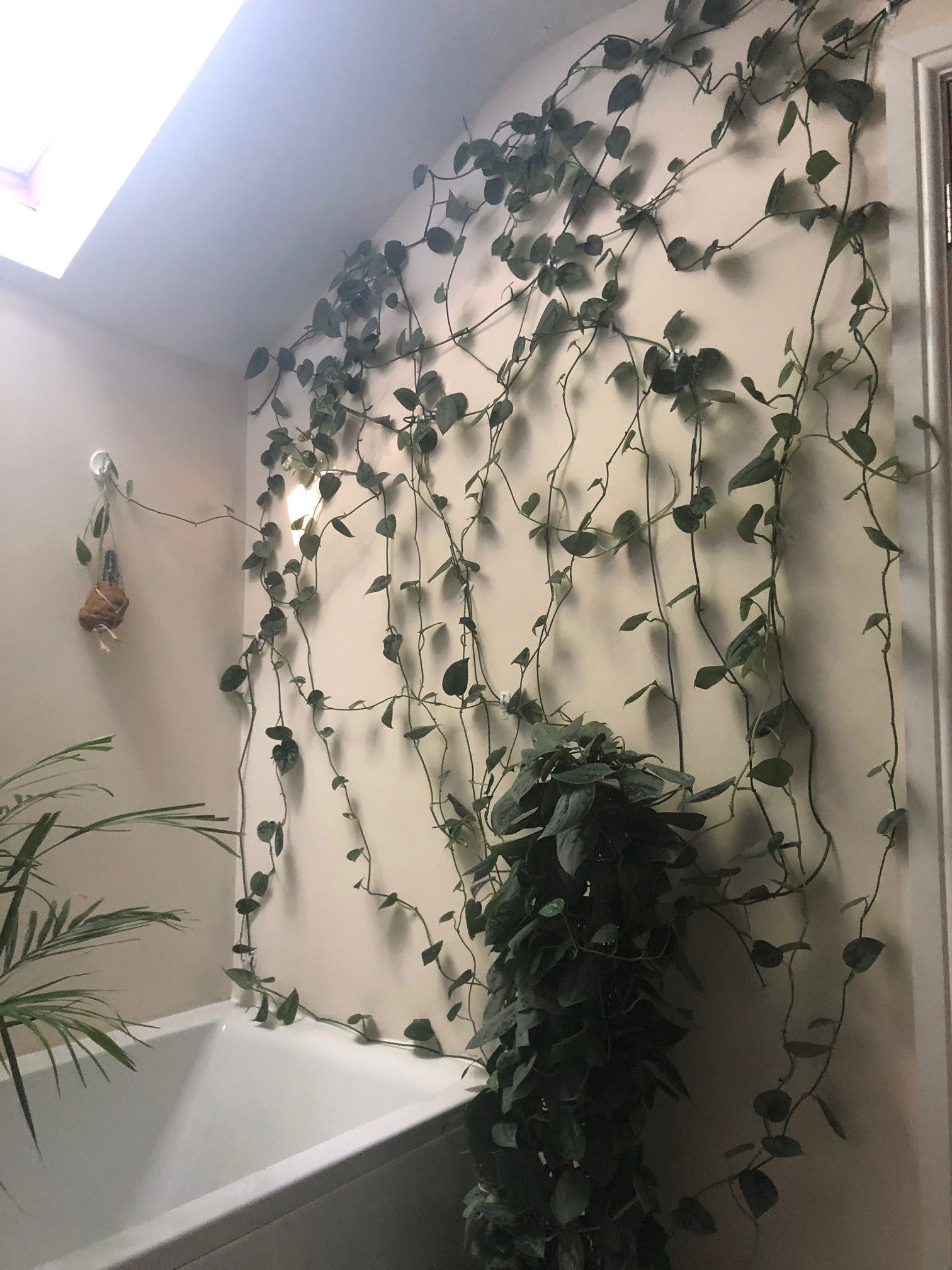 Devil's Ivy are an excellent choice to fill a bare wall within a year or two. The vines are held by 3M Adhesive Pad Hooks.
Devil's Ivy are an excellent choice to fill a bare wall within a year or two. The vines are held by 3M Adhesive Pad Hooks.
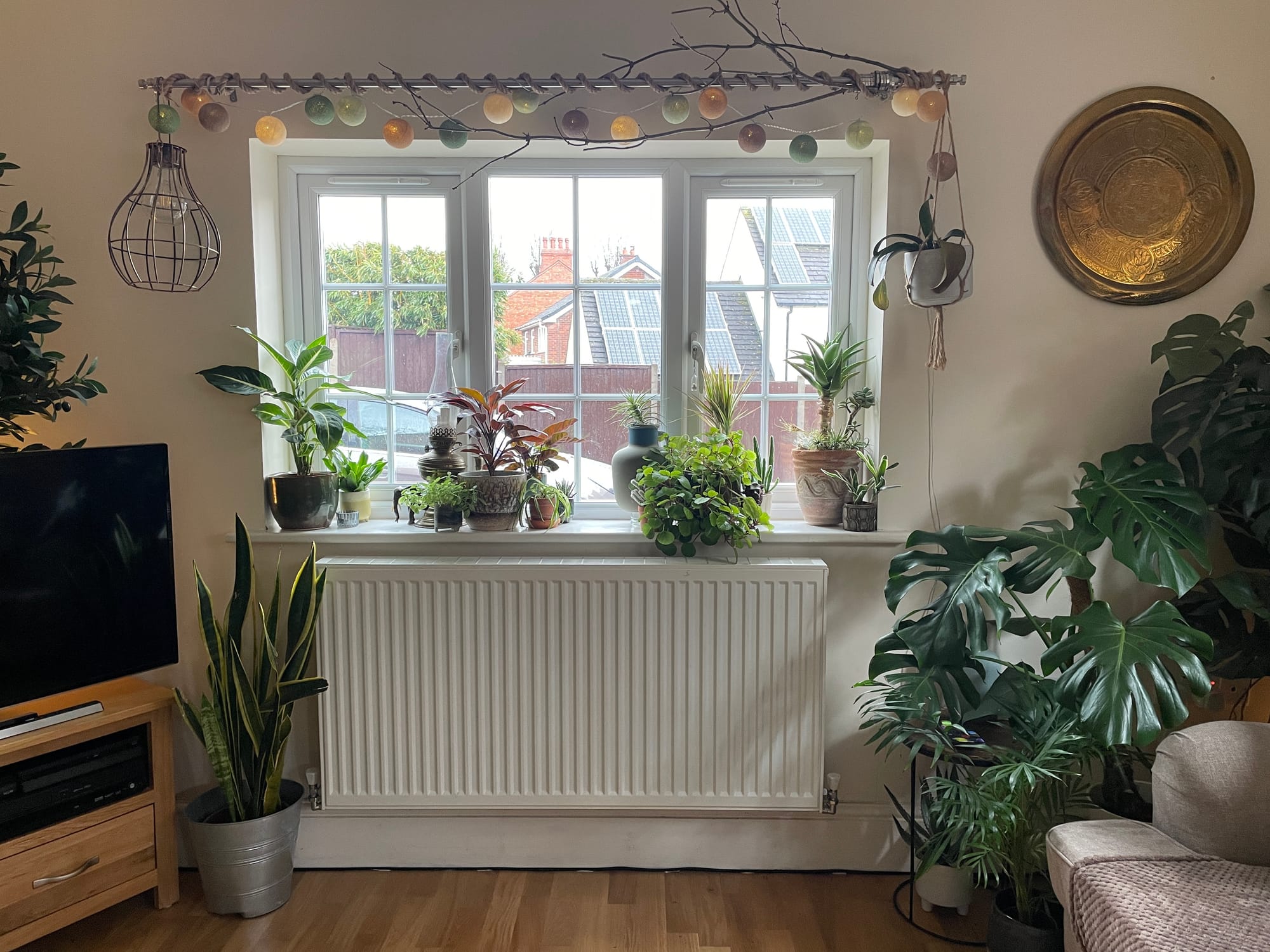 Here's THE HOUSEPLANT DOCTOR™ 's north-facing windowsill with a selection of his favourite plants.
Here's THE HOUSEPLANT DOCTOR™ 's north-facing windowsill with a selection of his favourite plants.
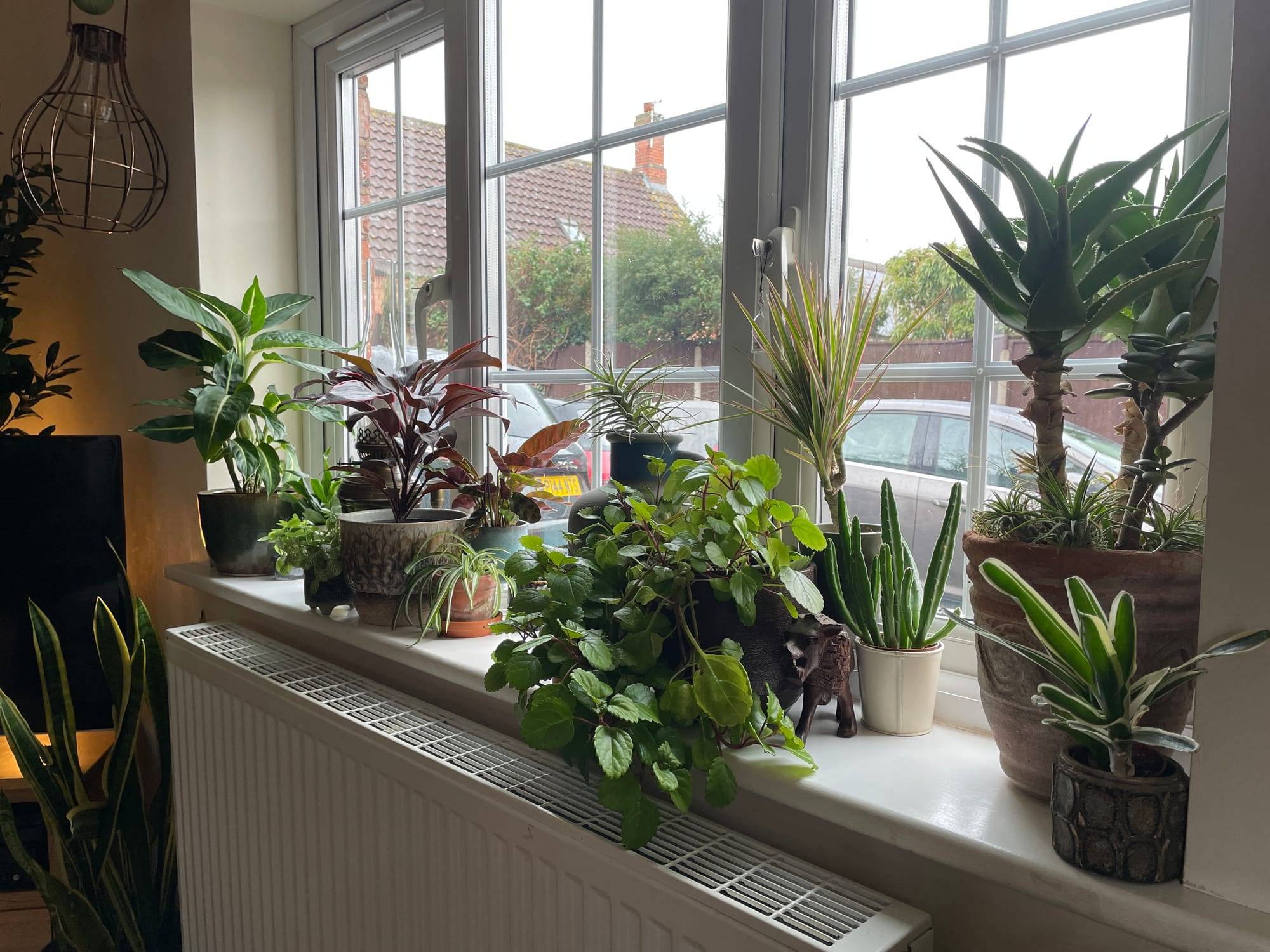 Another angle of his north-facing windowsill. Note: the radiator below doesn't work, otherwise it would potentially scorch the plants when operating.
Another angle of his north-facing windowsill. Note: the radiator below doesn't work, otherwise it would potentially scorch the plants when operating.
 Struggling with low light? Why not re-use an old cabinet or shelf with LED strip growlights (found on Amazon, etc.). These plants have been happily growing in THE HOUSEPLANT DOCTOR™ 's cabinet for around three years.
Struggling with low light? Why not re-use an old cabinet or shelf with LED strip growlights (found on Amazon, etc.). These plants have been happily growing in THE HOUSEPLANT DOCTOR™ 's cabinet for around three years.
 Here's another of his cabinets with growlights attached. If you grow 'common' houseplants in a lit cabinet, you won't need a humidifier or fan as these are only used for more 'delicate' or rarer plants. A simple set-up is good here!
Here's another of his cabinets with growlights attached. If you grow 'common' houseplants in a lit cabinet, you won't need a humidifier or fan as these are only used for more 'delicate' or rarer plants. A simple set-up is good here!
Sun-Filled Rooms
When purchasing a new plant from the local store, its label will likely declare the avoidance of direct light. Although this is mostly true, many indoor plants will always benefit from an hour of early morning or late evening sun throughout the autumn and winter months. As long as there’s enough soil moisture during this time, the sun’s nutrients will provide much-needed nourishment during the height of its dormancy period, along with stimulating the 'water-cycle' within the soil.
The list below consists of specimens that can endure several hours of intense light, even through the summer when the sun is at its zenith. Those who have an Asterix (*) by their name must be accompanied by moist soil to counteract the heightened risk of dehydration.
Building Your Plant's Sun Tolerance
THE HOUSEPLANT DOCTOR™ NEVER recommends placing a shop or nursery bought houseplant immediately into the direct sunlight without a period of tolerance building. Most greenhouses, where plants are mass-produced, will be grown under natural light or specialist UV grow lights, so their leaves will be rather delicate and thin. Exposing your specimen to the harsh rays without an introductory period will quickly result in sun-scorch, dehydration and weakened health.
We recommend giving your plant an hour of morning or evening sunlight each day for around a week, before increasing this by an hour or two every fourteen days. Although the severity and risk of developing sun-scorch will be halved during the late autumn and winter period, this doesn't necessarily mean you should skip the introductory period. If you have already faced issues with sun-scorch, be sure to hop over to this article on learning more on this issue!
- Aeoniums - House Leeks
- Agaves - Tequila Plants
- Agapanthus*
- Aloe Vera
- Banana Palms*
- Bird of Paradise - Strelitzia
- Burro's Tails
- Carnivorous Plants* - Venus Fly Traps, Pitcher Plants, Nepenthes, Drosera, Pinguicula, Darlingtonia & Others
- Crotons*
- Desert Cacti (NOT Tropical or Epiphytic Cacti)
- Dichondra*
- Epidendrums*
- Euphorbia trigona - African Milk Bush
- Geranium
- Hibiscus*
- Jasmine*
- Kalanchoe
- Mother of Millions/Thousands
- Lithops - Living Stones
- Oxalis triangularis - False Shamrock
- Pachypodium
- Papyrus*
- Ponytail Palms - Beaucarnea or Nolina
- Sago Palms - Cycads & Zamia
- Sansevieria - Mother-In-Law's Tongue / Snake Plant, Rocket Plants, African Spears & Others
- Silver Squill - Ledebouria socialis
- String of Pearls, Bananas or Dolphins
- Most Succulents - Aloe, Crassula, Curio, Echeveria, Euphorbia, Gasteria, Haworthia, Portulacaria afra, Sedum, Sempervivum, Senecio & Others
- Vegetables & Fruits - Capsicum (Peppers), Tomatoes & Strawberries, etc.
- Yucca
 THE HOUSEPLANT DOCTOR™ 's south-facing windowsill that also receives heat from the radiator (not pictured) below when operating.
THE HOUSEPLANT DOCTOR™ 's south-facing windowsill that also receives heat from the radiator (not pictured) below when operating.
Bedrooms - Air-Purifying Plants for Better Sleep & Well-Being
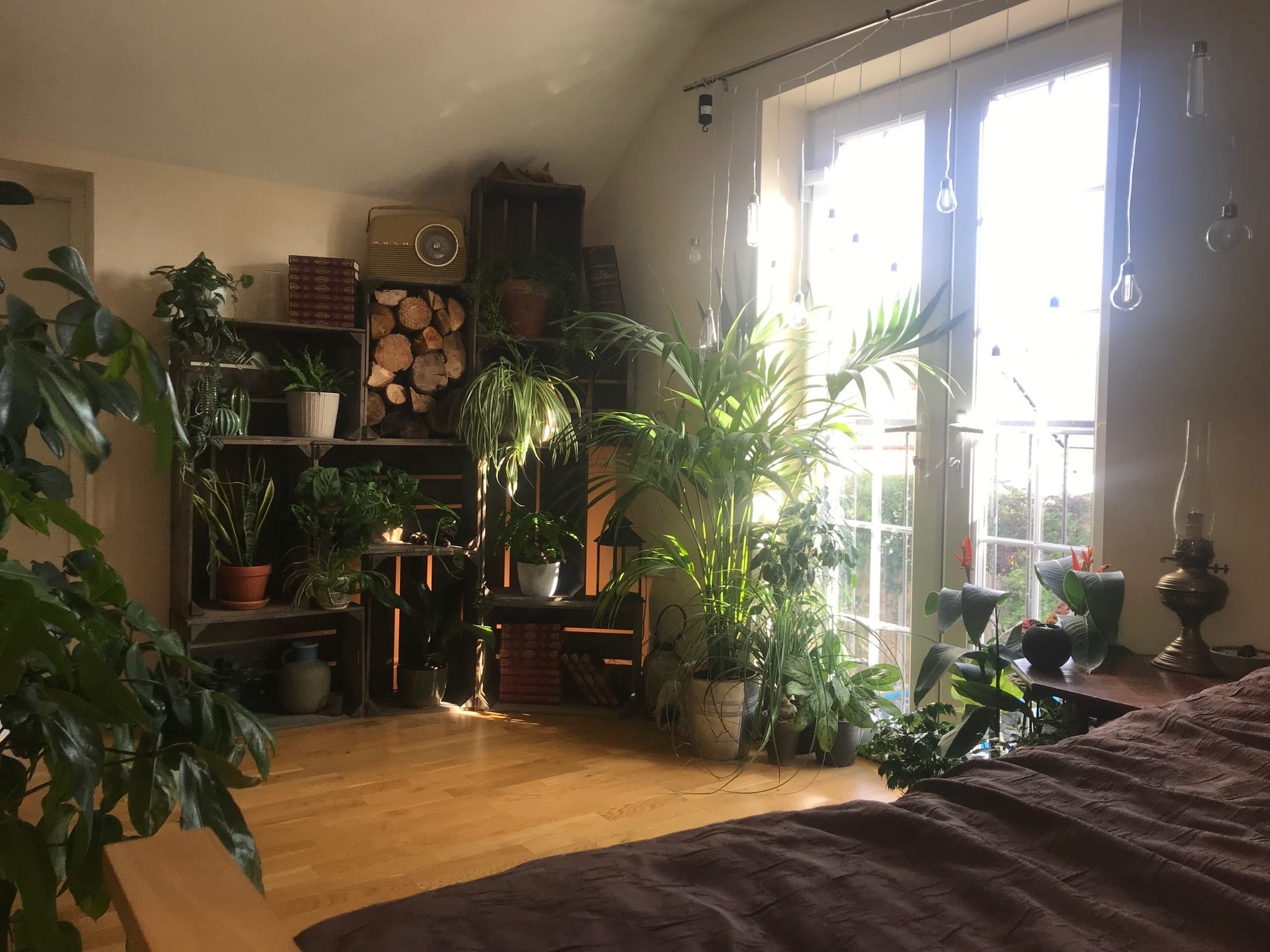
Most houseplants will remove airborne toxins and carbon dioxide from the atmosphere, even if they're not labelled as air-purifying. Toxin polluting-sources include electrical appliances, fire places, wet-paint particles, faecal matter & mould. This list comprises of the top 15 plants for cleaning & maintaining your home's air quality. Again, the plants in bold are pet-friendly.
- Aloe vera (Formaldehyde, Benzene)
- Bromeliads - Aechmea, Billbergia, Bromelia, Cryptanthus, Guzmania, Helicodea, Vrisea & Others (Formaldehyde & Benzene)
- Chinese Evergreens (Formaldehyde, Benzene)
- Chrysanthemums (Ammonia, Benzene)
- Devil's Ivy - Epipremnum, Scindapsus & Pothos (Trichloroethylene, Xylene)
- Dracaena - Dragon Tree, Corn Plants & Lucky Bamboo (Trichloroethylene, Xylene)
- English or Common Ivy - Hedera (Mould & Faecal Particles)
- Ferns - Boston (Nephrolepis), Blechnum, Dryopteris, Maidenhair (Adiantum) & Rabbit Foot Ferns (Formaldehyde, Benzene)
- Gerbera - Barberton Daisy (Formaldehyde, Trichloroethylene, Benzene)
- Palms - Parlour, Areca, Fishtail* & Kentia (Ammonia) *Not Pet-Friendly
- Peace Lilies - Spathiphyllum (Formaldehyde, Trichloroethylene, Benzene)
- Prayer or Living Plants (Formaldehyde, Trichloroethylene & Benzene)
- Sansevieria - Mother-In-Law's Tongue / Snake Plant, Rocket Plants & African Spears (Formaldehyde, Xylene, Toluene & Benzene)
- Spider Plants (Large Amounts of Carbon Dioxide, & Xylene)
- Weeping Figs (Trichloroethylene, Xylene & Toluene)
Click here to learn more about domestic toxins & our Top 10 Air-Purifying Houseplants!
Bathroom Plants
Most houseplants will thrive in a bathroom; however, succulents should be avoided as the combination of humid air, and potential over-watering will quickly lead to rot or mildew. If your bathroom isn’t supported by enough natural light, always keep the soil on the drier side as this too can cause moisture-related issues. Keeping the bathroom door open after a shower or bath will allow moist air to circulate around the nearby rooms, increasing the airborne saturation somewhat.
- Aglaonema - Chinese Evergreen
- Air Plants*
- Alocasia - Elephant's Ears & African Mask
- Anthurium - Flamingo Flowers
- Aspidistra - Cast Iron Plant
- Banana Palms*
- Bird of Paradise - Strelitzia
- Bonsai
- Bromeliads* - Aechmea, Billbergia, Bromelia, Cryptanthus, Guzmania, Helicodea, Vrisea & Others
- Calathea - Prayer or Living Plants
- Carnivorous Plants* - Venus Fly Traps, Pitcher Plants, Nepenthes, Drosera, Pinguicula, Darlingtonia & Others
- Colocasia & Leucocasia
- Crotons
- Devil's Ivy - Epipremnum, Scindapsus & Pothos
- Dieffenbachia - Dumb Canes
- Dracaena - Dragon Tree & Lucky Bamboo
- Ferns - Boston (Nephrolepis), Blechnum, Dryopteris, Maidenhair (Adiantum) & Rabbit Foot Ferns
- Ficus - Weeping Figs, Fiddle-Leaf Figs & Bonsai Varieties
- Hoya
- Jewel Orchids - Ludisia
- Maranta
- Monstera - M. deliciosa, M. adansonii, M. obliqua & M. minima (Rhaphidophora tetrasperma)
- Murdannia loriformis
- Nerve Plants - Fittonia
- Orchids* - Moth Orchids (Phalaenopsis), Dendrobiums, Cymbidiums, Epidendrums, Cattleya, Paphiopedilum & Others
- Palms - Parlour, Areca, Fishtail*, Lady Palms & Kentia. *Not Pet-Friendly
- Peace Lilies - Spathiphyllum
- Peperomia*
- Persian Shield - Strobillanthes dyerianus
- Philodendron
- Piggyback Plant - Tolmiea menziesii
- Pilea - Friendship Plants & Missionary/Pancake Plants
- Pineapple Plants
- Polka Dot Plants - Hypoestes phyllostachya
- Sansevieria - Mother-In-Law's Tongue / Snake Plant, Rocket Plants, African Spears & Others
- Schlumbergera - Christmas, Holiday, Thanksgiving & Easter Cactus
- Senecio cephalophorus
- Spider Plants
- Staghorn Ferns*
- Syngonium
- Tropical Cacti - Epiphyllum, Fishbone Cacti, Disocactus, Hylocereus & Hatiora/Rhipsalis
- Umbrella Trees - Schefflera
- Yucca*
- ZZ Plants*
* Be careful of over-watering or misting, as too high humidity will cause a rotten specimen.
Dark Bathrooms with Minimal Lighting
As mentioned in the 'Dark Rooms / North Facing Rooms' section at the top, it's all about keeping specimens on the drier side to life to avert over-watering and root rot. If you're interested in learning more about counteracting the slowed rates of photosynthesis and water uptake in the roots, be sure to scroll upwards. Again, plants in bold are pet-friendly.
- Aspidistra - Cast Iron Plant
- Devil's Ivy - Epipremnum, Scindapsus & Pothos
- Jewel Orchids - Ludisia
- Nerve Plants - Fittonia
- Peace Lilies - Spathiphyllum
- Sansevieria - Mother-In-Law's Tongue / Snake Plant, Rocket Plants, African Spears & Others
- Schlumbergera - Christmas, Holiday, Thanksgiving & Easter Cactus
- Spider Plants
- Tropical Cacti - Epiphyllum, Fishbone Cacti, Disocactus, Hylocereus & Hatiora/Rhipsalis
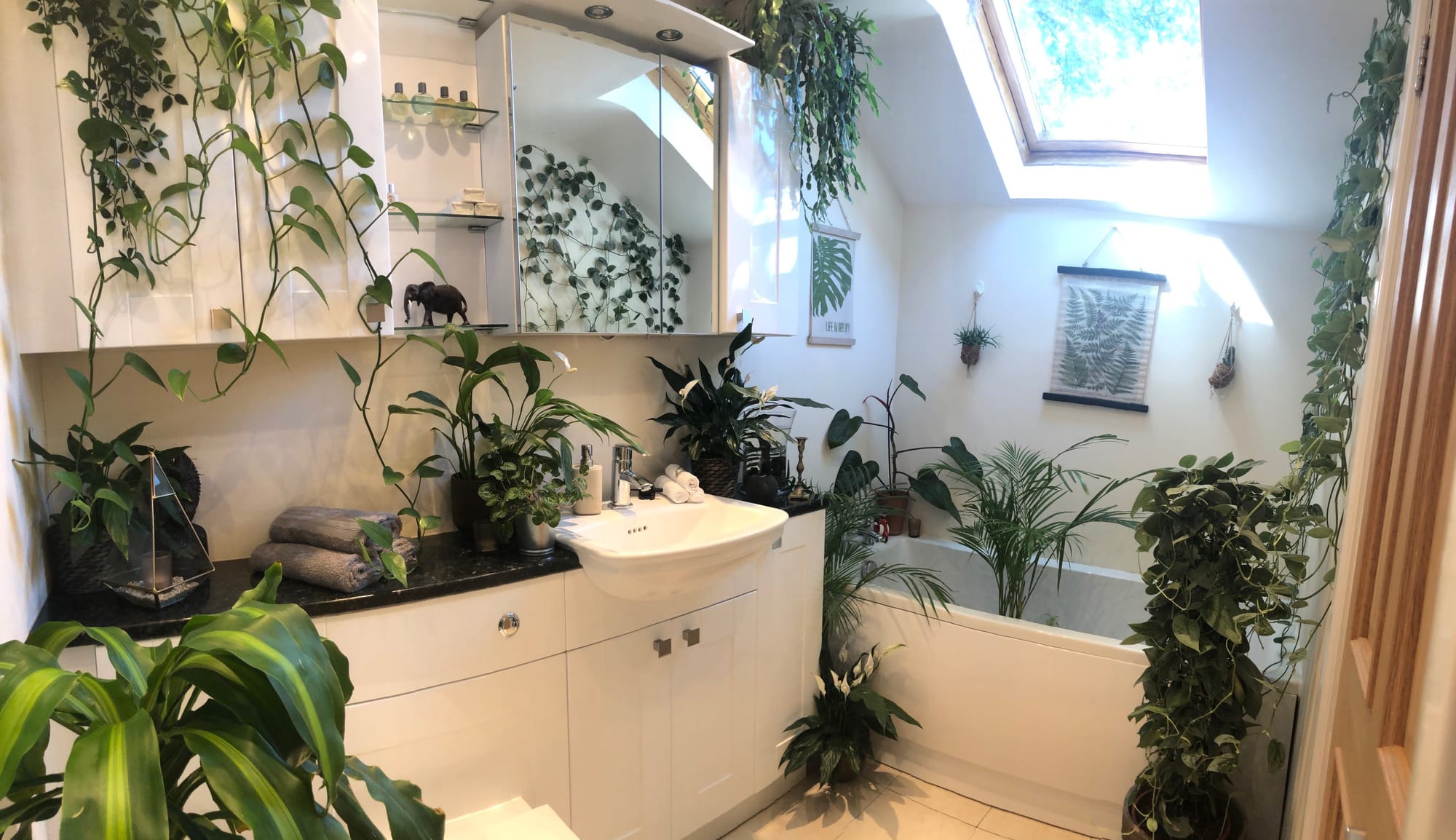 Our bathroom favourites are Peace Lilies, Devil's Ivy & Christmas Cacti..
Our bathroom favourites are Peace Lilies, Devil's Ivy & Christmas Cacti..
Cold or Draughty Rooms
Although some specimens won't mind a cold or draughty room, there are some that HATE it. The section below mentions most of the houseplants that can be placed in rooms of 12 - 18℃ (54 - 64℉).
Cold or Draught Tolerate Plants:
- Agaves - Tequila Plants
- Amaryllis (during their dormancy period over the spring and summer)
- Anthurium - Flamingo Flowers
- Aspidistra - Cast Iron Plant
- Azalea
- Banana Palms - Musa
- Bougainvillea
- Bird of Paradise - Strelitzia
- Callisia
- Carnivorous Plants - Venus Fly Traps, Pitcher Plants, Nepenthes, Drosera, Pinguicula, Darlingtonia & Others
- Citrus (fine with temperature, NOT with draughts)
- Clivia - Natal or Bush Lilies
- Colocasia & Leucocasia - Elephant Ears
- Crassula
- Cyclamen
- Daffodils
- Dichondra
- English or Common Ivy - Hedera
- Hoya
- Hyacinths
- Fatsia japonica
- Jasmine
- Maidenhair Vines - Meuhlenbeckia
- Money or Jade Plants
- Rose
- Oxalis - False Shamrock Plant
- Pilea - Friendship Plants & Missionary/Pancake Plants
- Sago Palms - Cycads & Zamia
- Spider Plants
- Streptocarpus - Cape Primrose
- Tradescantia
- Tropical Cacti - Epiphyllum, Fishbone Cacti, Disocactus, Hylocereus & Hatiora/Rhipsalis
- Umbrella Trees - Schefflera
- Yucca
As usual, those in bold are pet-friendly.
Cold or Draught Haters:
- Begonia (fine with temperature, NOT with draughts)
- Bonsai
- Prayer or Living Plants
- Crotons
- Maranta
- Nerve Plants - Fittonia
Read More - List of Toxic & Pet-Friendly Houseplants
Plants That Don't Mind A Nearby Radiator
Most plants, especially those from tropical origins, must not be situated within three metres of an operating heater. Those sat too closely will develop browning leaf-tips and stunted growth from the dry air that gets churned out. This list below shows plants that can be placed within two metres of a radiator, and those with an Asterix (*) must be offered good soil moisture to prevent the risk of dehydration. The plants in bold are pet-friendly.
- Aechmea & Billbergia (types of Bromeliad)*
- Aeoniums - House Leeks
- Agaves - Tequila Plants
- Crassula - Jade or Money Plants
- Desert Cacti
- Desert Terrariums
- Ficus - Rubber Plants, Weeping Figs, Ficus Audrey & Others
- Ponytail Palms - Beaucarnea or Nolina
- Sago Palms - Cycads*
- Sansevieria - Mother-In-Law's Tongue / Snake Plant, Rocket Plant, African Spear, etc.
- Most Succulents - Aloe, Crassula, Curio, Echeveria, Euphorbia, Gasteria, Haworthia, Portulacaria afra, Sedum, Sempervivum, Senecio & Others
- Umbrella Trees - Schefflera
- Yucca
- ZZ Plants
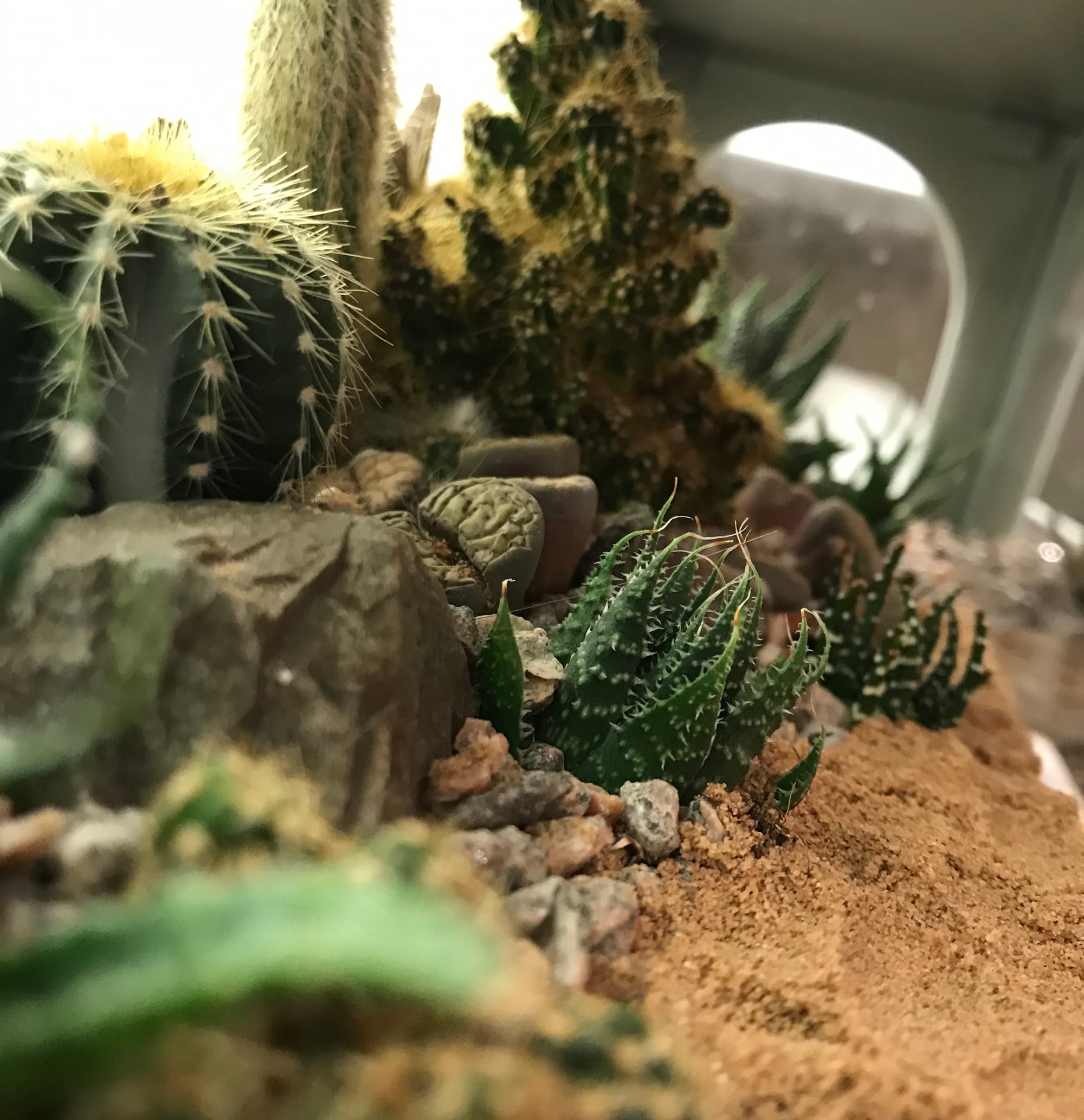
Desert Cacti are the 'go-to' plants for a dry room; whereas ZZ Plants or Umbrella Trees are best for statement plants.
Houseplants That Can Be Placed Outside During the Summer
Most plants will benefit from an episode outside, once the nighttime temperatures are above 14℃ (57℉). Keeping them in a sheltered spot away from the direct sunlight will reward you with new healthy growth within the next few weeks. Always keep an eye out for pests, especially when re-introducing it back into the home once the temperatures dip. Plants that will be most benefited with a spell outdoors are Agaves, Carnivorous Plants, Desert / Tropical Cacti, Orchids (to reflower), Oxalis & Yuccas.
Plants that must be grown under glass (i.e. indoors) are listed below - its reason could be the higher risk of dehydration, pest-attacks or too low temperatures.
- Air Plants - Dehydration, Pest Attacks, Sun-Scorch & Loosing It Outdoors
- Bonsai - Dehydration & Sun-Scorch
- Cyclamen - Environmental Shock & Vine Weevils. Keep outdoor-varieties out & indoor-species in
- Most Ferns - Dehydration & Sun-scorch
- Streptocarpus - Aphids
Book a 1-to-1 Consultation with THE HOUSEPLANT DOCTOR™
Need realtime advice for your houseplants? Book a video or message consultation with expert Joe Bagley, THE HOUSEPLANT DOCTOR™ (author or ukhouseplants.com). Choose between a ten or thirty-minute session & a platform of your choice (WhatsApp, FaceTime, Facebook Messenger or Zoom). Ask unlimited questions in one session, including queries on your dying/challenging plants, pests eradication, terrariums, repotting advice & everything in between! Available worldwide.